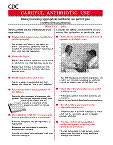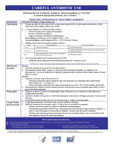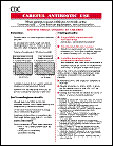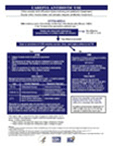Pediatric Treatment Guidelines:
Upper Respiratory Tract Infections
(For Clinicians)
On This Page
One Page Pediatric Academic Detailing Sheets
These sheets are useful for conducting small group or one-on-one educational sessions. They have been used by many programs around the country seeking to change clinician prescribing behavior.
Practice Tips
Physician Information Sheet (Pediatrics)
Target Audience: Clinicians, Health Educators, Infection Control Professionals, Nurse Practitioners, Nurses, Physician Assistants, Physicians, Pharmacists
Provides useful messages explaining the growing threat of antibiotic resistance and alternative treatment methods.
Appropriate Treatment Summary
Physician Information Sheet (Pediatrics)
Target Audience: Clinicians, Health Educators, Infection Control Professionals, Nurse Practitioners, Nurses, Physician Assistants, Physicians, Pharmacists (UPDATED AUGUST 6, 2007)
Cough Illness/Bronchitis
Physician Information Sheet (Pediatrics)
Target Audience: Clinicians, Health Educators, Infection Control Professionals, Nurse Practitioners, Nurses, Physician Assistants, Physicians, Pharmacists
Provides key information on the treatment of bronchitis and other cold illnesses.
The Common Cold: Rhinitis Vs. Sinusitis
Physician Information Sheet (Pediatrics)
Target Audience: Clinicians, Health Educators, Infection Control Professionals, Nurse Practitioners, Nurses, Physician Assistants, Physicians, Pharmacists
When parents request antibiotics for rhinitis or the common cold, give them an explanation not a prescription. Provides information on treatment methods for common cold symptoms.
Otitis Media
Physician Information Sheet (Pediatrics)
Target Audience: Clinicians, Health Educators, Infection Control Professionals, Nurse Practitioners, Nurses, Physician Assistants, Physicians, Pharmacists
Provides information on differentiating acute otitis media from otitis media with effusion.
Pharyngitis: Treat Only Proven GAS
Physician Information Sheet (Pediatrics)
Target Audience: Clinicians, Health Educators, Infection Control Professionals, Nurse Practitioners, Nurses, Physician Assistants, Physicians, Pharmacists
Provides medical data on viral vs. bacterial throat infections in children and the clinical procedures for distinguishing between each.
Publications - Principles for Pediatric Appropriate Antibiotic Use
- Principles of Judicious Use of Antimicrobial Agents for Pediatric Upper Respiratory Tract Infections
Dowell SF, Marcy SM, Phillips WR, Gerber MA, Schwartz, B. Pediatrics. 1998;101:163-165.
The guidelines in this article provide evidence-based principles focused on situations in which antimicrobial therapy could be curtailed without compromising patient care. The paper addresses five common upper respiratory infections that account for the majority of outpatient antimicrobial use: otitis media, sinusitis, bronchitis, pharyngitis, and nonspecific upper respiratory tract infection.
Abstract - Diagnosis and Management of Cough: ACCP Evidence-Based Clinical Practice Guidelines
Irwin RS, Baumann MH, Bolser DC, et al: Diagnosis and management of cough: ACCP evidence-based clinical practice guidelines. Chest 1S-292S, 2006.
These practice guidelines (1) more narrowly focuses the guidelines on the diagnosis and treatment of cough, the symptom, in adult and pediatric populations, and minimizes the discussion of cough as a defense mechanism; (2) improves on the rigor of the evidence-based review and describes the methodology in a separate section; (3) updates and expands, when appropriate, all previous sections; and (4) adds new sections with topics that were not previously covered.
Cough Guidelines on the Chest website - Diagnosis and Management of Otitis Media with Effusion
American Academy of Family Physicians, American Academy of Otolaryngology-Head and Neck Surgery, and American Academy of Pediatrics Subcommittee on Otitis Media With Effusion: Otitis media with effusion. Pediatrics 113:1412-1429, 2004.
The purpose of this guideline is to inform clinicians of evidence-based methods to identify, monitor, and manage Otitis Media with Effusion (OME) in children aged 2 months through 12 years.
OME Guidelines on the Pediatrics website - Diagnosis and Management of Acute Otitis Media
Subcommittee on Management of Acute Otitis Media: Diagnosis and management of acute otitis media. Pediatrics 113:1451-1465, 2004.
This evidence-based clinical practice guideline provides recommendations to primary care clinicians for the management of children from 2 months through 12 years of age with uncomplicated Acute Otitis Media (AOM).
AOM Guidelines on the AAFP website - Pharyngitis--Principles of Judicious Use of Antimicrobial Agents
Schwartz B, Marcy SM, Phillips WR, Gerber MA, Dowell SF. Pediatrics. 1998;101:171-174.
Clinical findings cannot reliably differentiate streptococcal from viral pharyngitis. Many physicians overestimate the probability of a bacterial infection based on history and physical examination alone. Diagnosis of pharyngitis should be based on results of a throat culture or antigen-detection test with throat culture as a back-up. Accurate diagnosis of group A streptococcal pharyngitis and choosing appropriate antimicrobial therapy are important, particularly to prevent nosuppurative sequelae such as rheumatic fever.
Abstract - Acute Sinusitis--Principles of Judicious Use of Antimicrobial Agents
O'Brien KL, Dowell SF, Schwartz B, Marcy SM, Phillips WR, Gerber , MA . Pediatrics. 1998;101:174-177.
This article outlines the strict criteria for clinical diagnosis of sinusitis. An accurate diagnosis is difficult, but critical because viral sinusitis is 20 to 200 times more common than bacterial infection of the sinuses.
Abstract - Cough Illness/Bronchitis--Principles of Judicious Use of Antimicrobial Agents
O'Brien KL, Dowell SF, Schwartz B, Marcy SM, Phillips WR, Gerber , MA . Pediatrics. 1998;101:178-181.
Millions of courses of antibiotics are prescribed for children with acute cough illness each year, despite evidence that it is not effective. Evidence for the treatment guidelines recommended for cough illness/ bronchitis are presented.
Abstract - The Common Cold--Principles of Judicious Use of Antimicrobial Agents.
Rosenstein N, Phillips WR, Gerber MA, Marcy SM, Schwartz B, Dowell SF. Pediatrics. 1998;101:181-184.
Unnecessary antimicrobial therapy for the common cold can be avoided by recognizing the symptoms that are part of the usual course of the illness. Controlled trial evidence is reviewed and presented to support the recommendations made in this paper.
Abstract - IDSA Clinical Practice Guideline for Acute Bacterial Rhinosinusitis in Children and Adults
Chow AW, Benninger MS, Itzhak B, et al: Clin Infect Dis. 2012 Apr; 54(8):e72-e112. Epub 2012 Mar 20.
Evidence-based guidelines for the diagnosis and initial management of suspected acute bacterial rhinosinusitis in adults and children.
Abstract
![]() This symbol means you are leaving the CDC.gov Web site. For more information, please see CDC's Exit Notification and Disclaimer policy.
This symbol means you are leaving the CDC.gov Web site. For more information, please see CDC's Exit Notification and Disclaimer policy.
File Formats: All viewers, players, and plug-ins used on this site can be downloaded from the file formats page. (For example: Adobe Acrobat Reader for pdf files, Windows Media Player for audio and video files, PowerPoint Viewer for presentation slides, etc.)
Copyrighted images: Images on this website which are copyrighted were used with permission of the copyright holder and are not in the public domain. CDC has licensed these images for use in the materials provided on this website, and the materials in the form presented on this website may be used without seeking further permission. Any other use of copyrighted images requires permission from the copyright holder.
Contact Us:
- Centers for Disease Control and Prevention
1600 Clifton Rd
Atlanta, GA 30333 - 800-CDC-INFO
(800-232-4636)
TTY: (888) 232-6348 - New Hours of Operation
8am-8pm ET/Monday-Friday
Closed Holidays - cdcinfo@cdc.gov








